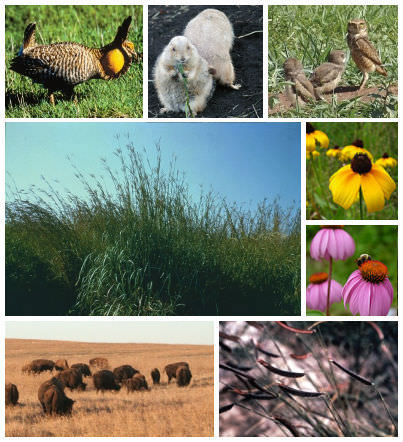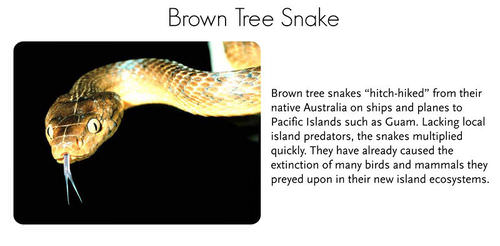18.39 第六批大规模灭绝 -- -- 高级
章节大纲
-
This is one of the most powerful in the world. Could it go extinct?
::这是世界上最强大的之一 它会灭绝吗?The Philippine Eagle, also known as the Monkey-eating Eagle, is among the rarest, largest, and most powerful birds in the world. It is critically endangered, mainly due to massive loss of habitat due to deforestation in most of its range. Killing a Philippine Eagle is punishable under Philippine law by twelve years in jail and heavy fines.
::菲律宾鹰(又称食猴鹰)是世界上最稀有、最大和最强大的鸟类之一。 它受到严重威胁,主要原因是大部分森林砍伐导致大量生境丧失。 根据菲律宾法律,杀害菲律宾鹰将被判处12年监禁和重罚。Causes of the Sixth Extinction
::导致第六次灭绝的原因Human Actions and the Environment
::人类行动与环境What are the causes of the Sixth Extinction ? There is nearly universal agreement that most result from human activities ( Table and Figure ). Although our activities have changed, we remain the single most able to alter the Earth’s genetic, species, and .
::第六次灭绝的原因是什么? 人类活动(表和图 ) 几乎是普遍一致的结果。 尽管我们的活动已经改变,但我们仍然是唯一能够改变地球基因、物种和(或)最能改变地球基因、物种和(或)的人。Human Settlement and Following Extinctions Continent/Island Human Settlement (Years Before Present) Extinctions Which Followed
::随之而来的灭绝Africa, Eurasia Humans evolve here relatively few extinctions Indonesia 50,000 50% of large mammal species Australia 40,000 55 species large mammals, , and birds
::55种大型哺乳动物和鸟类North and South America 10,000 - 12,500 70-80% of large mammals (at least 135 species) within 1000 years
::1000年内70-80%的大型哺乳动物(至少135种)Mediterranean Islands 10,000 large mammals and reptiles West Indies 7,000 Mammals, birds, reptiles all 5 endemic mammals of Puerto Rico
::波多黎各的哺乳动物、鸟类、爬行动物Madagascar 2,000 virtually all large endemic land mammals, reptiles, and birds within 1500 years Hawaiian Islands 1,500 (Polynesians) 250 (Europeans)
::1 500(波利尼西亚人) 250(欧洲人)2/3 of native vertebrate species, 90% of bird species after European arrival, 20 more bird species
::2/3的本地脊椎动物、90%的欧洲抵达后的鸟类、另外20种鸟类New Zealand 1,300 No mammals originally Frogs , lizards, and over 1/3 (40 species) of birds Large animal extinctions followed the arrival of humans in many regions of the world, suggesting that human activities caused the extinctions. Convincing evidence for human responsibility for Ice Age extinctions is outlined in Figure . Comparing Ice Age to pre-human extinctions provides more evidence:
::图1概述了对冰龄灭绝的人类责任的令人信服的证据。 将冰龄与人类灭绝之前的人类灭绝相比,提供了更多的证据:-
Ice Age extinctions affected large
disproportionately; pre-human extinctions affected all body sizes.
::冰河时代的灭绝影响特别大;人类之前的灭绝影响所有身体大小。 -
Ice Age extinctions occurred at different times in different regions; pre-human extinctions were global and simultaneous.
::不同区域不同时期发生冰龄灭绝;人类之前的灭绝是全球性的,同时发生。 -
Recent extinctions follow human
with regularity.
::近来的灭绝现象是随着人类的灭绝而来的,而且经常发生。 -
The “syncopated” pattern does not fit
climate
change, and earlier interglacial periods did not see similar extinctions.
::“综合”模式不适合气候变化,早先的冰川间时期没有看到类似的灭绝现象。
Although the data above has led to considerable agreement about human responsibility for the early Holocene extinctions, scientists still debate exactly how human activities caused extinctions. Hypotheses include:
::虽然上述数据已导致人们就人类对早期全球灭绝的责任达成相当一致的看法,但科学家们仍在讨论人类活动是如何造成灭绝的。-
Overkill
: Animals outside Africa and Eurasia evolved in the absence of humans. Many did not fear humans and would have been easily killed, explaining the disproportionate numbers of large species affected.
::过度杀戮:非洲和欧亚以外的动物在没有人类的情况下进化。 许多人并不害怕人类,很容易被杀,这解释了受影响物种数量过多的原因。 -
Cascade effects
: Extinctions of very large animals could have had major effects on ecosystems, including secondary extinctions. Loss of
predators
could have led to overpopulation and starvation of
prey
species. Loss of large
herbivores
would have affected their predators. Removal of even a single
keystone species
could have destabilized complex ecosystem interactions, leading to multiple extinctions.
::连锁效应:非常大型动物的灭绝可能对生态系统产生重大影响,包括二次灭绝;掠食动物的丧失可能导致食肉动物过度人口和饥饿;大型食草动物的丧失会影响其食肉动物;即使是单个关键物种的灭绝也会破坏复杂的生态系统互动,导致多重灭绝。 -
Disease
: Humans often brought along rats, birds, and other animals as they migrated to new regions. Animals in those new regions, however, would not have evolved resistance to the diseases they carried. Avian
malaria
, for example, is still spreading through Hawaii, having already caused the extinctions of many bird species.
::疾病:人类在迁移到新地区时常常带来大鼠、鸟类和其他动物。 但是,在这些新地区,动物不会对其携带的疾病形成抗药性。 比如,禽流感仍在夏威夷蔓延,已经导致许多鸟类物种灭绝。 -
by exotic animals
: The rats, birds, and other animals accompanying humans brought not only disease but also new appetites to regions where animals had evolved without predators. Like humans, these animals found the “naïve” prey easy to capture.
::与外来动物有关:大鼠、鸟类和其他伴随人类的动物不仅带来了疾病,也带来了新的食欲,来到动物在没有掠食动物的情况下进化的地区。 这些动物和人类一样,发现“幼兽”猎物很容易捕捉。 -
: Deforestation and
accompanied humans, and the loss of habitat inevitably resulted in loss of species.
:::砍伐森林和伴随而来的人类,以及生境的丧失不可避免地导致物种的丧失。
These effects of early human habitation foreshadow today’s even greater threats to biodiversity. Overpopulation, industrialization, technology, cultural differences, and socioeconomic disparities compound the six major causes of today’s Biodiversity Crisis. Most experts agree on the primary cause of extinction today:
::早期人类居住地的这些效应预示着今天对生物多样性的更大威胁。 人口过剩、工业化、技术、文化差异和社会经济差异加剧了当今生物多样性危机的六大原因。 多数专家都认为今天的灭绝的主要原因是:Causes of Extinction #1: Habitat Loss
::原因1:生境损失Habitat loss , degradation and fragmentation is universally accepted as the primary threat to biodiversity. Agriculture, forestry, mining, and urbanization have disturbed over half of Earth’s vegetated land. Inevitably, species disappear and biodiversity declines.
::生境的丧失、退化和支离破碎被普遍认为是对生物多样性的主要威胁。 农业、林业、采矿和城市化已经扰乱了地球一半的植被土地。 物种不可避免地消失,生物多样性下降。Conversion for agriculture is a major reason for habitat loss. Within the past 100 years, the area of land cultivated worldwide has increased 74%; grazing land increased 113%. Agriculture has cost the United States 50% of its wetlands and 99% of its tallgrass prairies. Native prairie ecosystems ( Figure ) - which comprise of thick, fertile soils, deep-rooted grasses, a colorful diversity of flowers , burrowing prairie dogs, owls and badgers, herds of bison and pronghorns, and booming prairie chickens, - are virtually extinct.
::过去100年来,全世界耕地面积增加了74%;牧场增加了113%;农业耗尽了美国50%的湿地和99%的高草草原;土著草原生态系统(图)——由厚厚、肥沃的土壤、根深蒂固的草原、花朵种类繁多的花朵、挖掘草原的狗、猫头鹰和坏人、野牛和草原的牧群以及兴旺的草原鸡组成——几乎绝种。Habitat loss is the #1 cause of extinction today. In the U.S., over 99% of tallgrass prairies have been eliminated in favor of agriculture. Big bluestem grasses as tall as a human (center) and (clockwise from top) prairie chickens, prairie dogs, burrowing owls, yellow and purple coneflowers, blue grama grass, and bison make up part of the prairie community. The largest cause of deforestation today is slash-and-burn agriculture ( Figure ), used by over 200 million people in forests throughout the world. Depletion of the surprisingly thin and nutrient-poor soil often results in abandonment within a few years, and subsequent erosion can lead to desertification. Half of Earth’s mature tropical forests are gone; one-fifth of tropical rain forests disappeared between 1960 and 1990. At current rates of deforestation, all tropical forests will be gone by 2090.
::如今,砍伐森林的最大原因是全世界森林中超过2亿人口使用的刀耕火种农业(图 ) 。 令人惊讶的薄质和营养贫瘠土壤的耗竭往往导致在几年内被抛弃,随后的侵蚀可能导致荒漠化。 地球一半成熟的热带森林已经消失;1960年至1990年间热带雨林的五分之一消失;以目前的毁林速度计算,所有热带森林都将在2090年前消失。Slash-and-burn agriculture is practiced by over 200 million people throughout the world; this photo was taken in Panama. Because of thin, nutrient-poor soils, plots are abandoned within just a few years. Experts predict that if current rates continue, all tropical forests will be gone by 2090. Poverty, inequitable land distribution, and overpopulation combine in third world countries to add pressure to already stressed habitats. Use of firewood, charcoal, crop waste, and manure for cooking and other energy needs further degrade environments, threatening biodiversity through habitat loss.
::第三世界国家的贫困、不公平的土地分配和人口过剩加在一起,增加了已经受到压力的生境的压力。 使用木柴、木炭、作物废物和粪便做饭和其他能源需要进一步破坏环境,从而威胁生物多样性,因为生境丧失。Causes of Extinction #2: Exotic (Alien or Invasive) Species
::灭绝原因2:外来(外星人或入侵)物种Technology has made the human species the most mobile species of any which has ever lived. Both intentionally and inadvertently, humans have extended their mobility to a great number of other species, as well. Ships from Polynesian times (as long ago as 3500 BP) to the present have transported crop species and domesticated animals as well as stowaway rats and snakes. Recently, cargo ships have transported Zebra Mussels, Spiny Waterfleas, and Ruffe deep into the Great Lakes via ballast . Europeans brought Purple Loosestrife and European Buckthorn to North America to beautify their gardens. Shakespeare enthusiast Eugene Schieffelin imported the now-ubiquitous European Starling to Central Park in the 1890s because he thought Americans should experience every bird mentioned in the works of Shakespeare. Australians imported the Cane Toad in an attempt to control the Cane Beetle, a native pest of sugar cane fields. The Brown Tree Snake ( Figure ) may have hitchhiked in the wheel-wells of military aircraft to Guam - and subsequently extirpated most of the island’s “naïve” vertebrate species.
::最近,货轮通过压舱将斑马沼泽、Spiny Waterfleas和Ruffe运入大湖深处。欧洲人将紫罗兰和欧洲巴克特霍恩带到北美,以美化他们的花园。莎士比亚最热衷于Eugene Schapfelin在1890年代将现在普遍存在的欧洲星城进口到中央公园,因为他认为美国人应该体验莎士比亚作品中提到的每只鸟。 澳大利亚人进口Cane Toad(Cane Toad ) , 试图控制甘蔗田的本地害虫Cane Beetle。 棕色树蛇(Figure ) 可能搭乘军用飞机的轮仓到关岛 — — 并随后将大多数岛屿的“脊椎 ” 。Many scientists consider exotic species to be the #2 cause of loss of biodiversity. One of the most infamous, the Brown Tree Snake (left), hitch-hiked on aircraft to Pacific Islands and caused the extinctions of many bird and mammal species which had evolved in the absence of predators. The Nile Perch (right) was intentionally introduced to Lake Victoria to compensate for overfishing of native species. The Perch itself overfished smaller species, resulting in the extinction of perhaps 200 species of cichlids. Many of these exotic (non-native) species , away from the predation or of their native habitats, have unexpected and negative effects in new ecosystems. Freed from natural controls, introduced species can disrupt , carry disease, out-compete natives for limited resources, or prey on native species directly - and lead to extinctions. Some hybridize with native species carefully tuned to local climate, predation, competition, and disease, resulting in genetic pollution which weakens natural adaptations . Others change the very nature of the habitats they invade; Zebra Mussels, for example, colonize most manmade and natural surfaces (including native mussels), filter-feeding so intensely that they increase water clarity and enrich bottom habitats with their waste.
::许多外来(非本地)物种远离掠夺或本地生境,在新的生态系统中产生意想不到的负面效应。免受自然控制,引进的物种可以破坏、传播疾病、与本地人竞争有限的资源或直接掠夺本地物种,并导致灭绝。有些物种与本地物种混合,仔细适应当地气候、掠夺、竞争和疾病,导致遗传污染,削弱自然适应。另一些物种则改变了他们入侵的生境的性质;Zebra Muselsels,例如,将大多数人造和自然表面(包括本地血管)殖民化,过滤喂食方式非常强烈,增加了水的清晰度,用废物丰富了底栖生境。Globalization and tourism are increasing the number of exotics which threaten biodiversity throughout the world, breaking down geographic barriers and threatening the wisdom of millions of years of evolution and . If current trends continue, our increasingly interconnected world will eventually be dominated by just a few fast-growing, highly adaptable, keenly competitive “super-species” rather than the rich diversity we have today. Some biologists, noting that invasive species closely resemble what we consider to be “weed” species, have concluded that the world’s #1 weed species is – did you guess it? – none other than Homo sapiens .
::全球化和旅游业正在增加威胁全世界生物多样性、打破地理障碍和威胁数以百万计年进化的智慧的外来物种的数量。 如果目前的趋势继续下去,我们日益相互关联的世界最终将只由少数快速增长、适应性强、竞争激烈的“超级物种 ” 而不是我们今天拥有的丰富多样性来主宰。 一些生物学家注意到入侵物种与我们所认为的“杂草”物种非常相似,因此得出结论,世界1号杂草物种 — — 你猜得到吗? — 除了智人之外,没有别的物种。Causes of Extinction #3: Overexploitation
::3号灭绝原因:过度开发The modern equivalent to overkill, overexploitation threatens fisheries, tropical rain forests, whales, rhinos, large carnivores and many other species. Practices such as clear-cutting old growth forests, strip mining, and driftnet fishing go beyond harvesting of single species or resources to degrade entire ecosystems. Technology-aided over-harvesting has reduced one of the richest fisheries in the world - the Grand Banks off the coast of Newfoundland – to an estimated 1% of what they were in 1977 ( Figure ). In 2003 in the journal Nature, Canadian biologists published an analysis of data showing that “industrialized” fishing has reduced large predatory worldwide by 90%. Some species' stocks are so depleted that less desirable species are illegally sold under the names of more expensive ones; in 2004, University of North Carolina graduate students tested from fish sold as “red snapper” from eight states and found that different species made up 77% of the fish tested! Overexploitation happens on the level of genes and ecosystems as well as individual species. Forest plantations, fish hatcheries and farms, and intensive agriculture reduce both species diversity and genetic diversity within species.
::现代的相当于过度捕捞、过度开发威胁到渔业、热带雨林、鲸鱼、犀牛、大型食肉动物和许多其他物种。 清除旧增长森林、脱衣采矿和流网捕捞等做法超越了单一物种或资源的捕捞,甚至使整个生态系统退化。 技术辅助过度捕捞使世界上最富有的渔业之一 — — 纽芬兰海岸外的大银行 — — 估计占1977年鱼量的1 % (Figure ) 。 2003年,加拿大生物学家在《自然》杂志上发表了一项数据分析,显示“工业化”捕捞使全世界大型掠食性减少了90 % 。 一些物种的种群被耗尽,以致于在更昂贵的物种名下非法出售不可取的物种;2004年,北卡罗来纳大学研究生们从八个州以“红松鼠”销售的鱼类中测试出77%的鱼类。 不同物种被过度开发发生在基因和生态系统以及个别物种的水平上。 森林种植园、养殖场和农场以及密集农业减少了物种的物种多样性和遗传多样性。Overexploitation of Atlantic cod threatens one of the world’s most productive fisheries: the Grand Banks off the coast of Newfoundland. Causes of Extinction #4: Global Climate Change
::4:全球气候变化Our increasing reliance on fossil fuels is altering the Earth’s atmosphere and climate. The effects include , breaks in the ozone layer shielding us from ultraviolet radiation, and greenhouse gases which raise the Earth’s air and ocean temperatures and sea levels. Burning tropical rain forests compounds the effect, releasing carbon as CO 2 and eliminating the forest’s ability to sequester carbon – remove carbon as CO 2 from the atmosphere - via . Inevitably, changing air and water temperatures, rainfall patterns, and salinity threaten species adapted to pre-warming conditions, and biodiversity declines globally. This concern is the topic of the Climate Change Lesson .
::我们日益依赖化石燃料正在改变地球的大气层和气候。 其影响包括保护我们免受紫外线辐射的臭氧层破裂,以及导致地球空气和海洋温度和海平面升高的温室气体。 燃烧热带雨林加剧了影响,释放碳作为二氧化碳,并消除森林固碳的能力 — — 将碳作为二氧化碳从大气中清除出来。 不可避免的是,变化中的空气和水温、降雨模式和盐度威胁到适应升温前条件的物种,以及全球生物多样性的下降。 这是气候变化教程的主题。Causes of Extinction #5: Overpopulation
::5号灭绝原因:人口过剩In 1960, Earth’s human stood at 3 billion. By 1999, we had grown to 6 billion. This unprecedented growth, together with developments in technology, has added immense pressure to resource and land use. Overpopulation compounds all of the aforementioned threats to biodiversity, and unequal distribution of resources extends the consequences to social and political instability. Human continues (see the chapter on Biology of Populations). Growth rates vary – ominously, from a biodiversity perspective: the highest rates are in third world tropical countries where diversity is also highest. We have already seen how slash-and-burn agriculture and Lake Victoria fisheries connect socioeconomic changes to loss of biodiversity.
::1960年,地球人口为30亿。 到1999年,我们已增长到60亿。 这一前所未有的增长,加上技术的发展,给资源和土地使用带来了巨大的压力。 人口过剩加剧了上述对生物多样性的威胁,资源分配不均也扩大了社会和政治不稳定的后果。 人类继续存在(见关于人口生物学的一章 ) 。 从生物多样性的角度来看,增长率不尽相同 — — 不祥地是:最高的增长率在第三世界热带国家,其多样性也最高。 我们已经看到刀耕火种的农业和维多利亚湖渔业是如何将社会经济变化与生物多样性的丧失联系起来的。Causes of Extinction #6: Pollution
::6号灭绝原因:污染Pollution adds chemicals, noise, heat or even light beyond the capacity of the environment to absorb them without harmful effects on life. To a certain extent, pollution has not kept pace with population growth, at least in Europe and the US. Startling events such as the oil-and-debris-covered and lifeless Cuyahoga River catching fire in 1969 finally provoked the U.S. to stop viewing air and waterways as convenient dumping grounds for waste. Environmental legislation, including the establishment of the Environmental Protection Agency (EPA) has improved both water and air quality. Heeding the warning provided by the extirpation of the Peregrine Falcon from the Eastern U.S., scientists discovered that many synthetic chemicals concentrate as they move through the food chain ( biological magnification ), so that toxic effects are multiplied. DDT – the cause of the Peregrine’s decline – was banned in the U.S., and regulation of pesticides was transferred from the Department of Agriculture to the EPA.
::污染增加了化学物质、噪音、热或光,超出了环境吸收这些物质而不给生命带来有害影响的能力。 在某种程度上,污染没有跟上人口增长的步伐,至少在欧洲和美国。 1969年的油和水覆盖和无生命的库亚霍加河大火等惊人事件最终促使美国停止将空气和水道视为废物的方便倾弃场。 环境立法,包括成立环境保护局(EPA),改善了水和空气质量。 科学家们借助东美Peregrinal Falcon的外溢提供的警告,发现许多合成化学品在通过食物链(生物放大)时聚集,因此毒性效应成倍增加。 滴滴涕 — — Peregrine的衰落原因 — — 在美国是被禁止的,杀虫剂管制从农业部转移到了EPA。And yet, pollution continues to contribute to habitat degradation worldwide, especially in developing countries.
::然而,污染继续导致全世界,特别是发展中国家的生境退化。-
: Knows no boundaries and growing concern about its effects on climate earn this topic two lessons later in this chapter. Acid rain,
, and
each affect diversity.
:::知道没有边界,对气候变化对气候的影响越来越关切,因此,本章后半部分得出了两个经验教训:酸雨(酸雨)和每种影响多样性。 -
: Especially from threatens vital freshwater and
resources in the US and throughout the world. Industrial and agricultural chemicals, waste, acid rain, and global warming threaten waters which are essential for all ecosystems. Threats to water resources are discussed in Lesson 2.
::工业和农业化学品、废物、酸雨和全球变暖威胁到水,而水对所有生态系统都至关重要。 -
Soil Contamination
: Toxic industrial and municipal wastes, salts from irrigation, and pesticides from agriculture all degrade soils - the foundations of
ecosystems and their biodiversity. These and other threats to soils are discussed in Lesson 2,
Natural Resources
.
::土壤污染:有毒工业和市政废物、灌溉盐类和农业杀虫剂都使土壤退化——生态系统及其生物多样性的基础,这些和对土壤的其他威胁在第二课“自然资源”中讨论。
Outside the developed world, pollution controls lag behind those of the U.S. and Europe, and developing nations such as China are rapidly increasing levels of pollution. Many pollution problems remain in industrialized countries, as well: industry and technology add nuclear waste disposal, oil spills, thermal pollution from wastewater , light pollution of the night skies, acid rain, and more to the challenges facing Earth’s biodiversity. Many will be discussed in the following lesson on Natural Resources, and you can certainly research more about those which interest or concern you. Our next task will be to switch from the doomsday report of problems and causes to a discussion of what WE – ordinary citizens – can do to help protect Earth’s biodiversity.
::在发达国家之外,污染控制落后于美国和欧洲,中国等发展中国家污染水平正在迅速上升。 许多污染问题在工业化国家也依然存在:工业和技术增加了核废物处理、石油泄漏、废水热污染、夜间轻光污染、酸雨以及地球生物多样性所面临的更多挑战。 许多问题将在关于自然资源问题的以下教训中讨论,你肯定可以更多地研究那些令你感兴趣或令你担心的问题。 我们的下一个任务是从关于问题和原因的末日报告转向讨论我们普通公民能做些什么来帮助保护地球生物多样性。Disappearing Frogs
::消失的青蛙Around the world, frogs are declining at an alarming rate due to threats like pollution, disease, and climate change. Frogs bridge the gap between water and land habitats, making them the first indicators of ecosystem changes. Meet the California researchers working to protect frogs across the state and across the world and learn about the plight of the yellow-legged frog.
::世界各地青蛙由于污染、疾病和气候变化等威胁而以惊人的速度下降。 青蛙缩小了水与土地生境之间的差距,成为生态系统变化的第一个指标。 加利福尼亚州研究人员致力于保护全州和世界各地的青蛙,并了解黄腿青蛙的困境。Nonnative Species
::非本地物种Scoop a handful of critters out of the San Francisco Bay and you'll find many organisms from far away shores. Invasive kinds of mussels, fish, and more are choking out native species, challenging experts around the state to change the human behavior that brings them here.
::从旧金山湾挖出一小撮动物,你会发现来自远岸的许多生物。入侵性的贝类、鱼类和更多的生物正在窒息本地物种,挑战国家周围的专家改变人类行为,而人类行为却把他们带到这里来。Summary
::摘要-
Human hunting, secondary effects on other species, disease carried and predation by exotic animals, and habitat destruction contributed to Ice Age extinctions.
::人类狩猎、对其它物种的次级影响、外来动物携带和掠夺的疾病以及生境的破坏导致了冰河时代的灭绝。 -
Habitat loss, including degradation and fragmentation, is the primary cause of extinction today; agriculture and deforestation continue to claim vegetated land and pollute both fresh and salt water seas.
::生境丧失,包括退化和支离破碎,是今天消失的主要原因;农业和毁林继续夺去植被土地,污染淡水和咸水。
-
Slash-and-burn agriculture is destroying tropical forest at rates which could result in total loss by 2090.
::刀耕火种的农业正在破坏热带森林,其速率可能到2090年造成全部损失。 -
In the U.S., agriculture has eliminated 50% of wetlands and 99% of tallgrass prairies.
::在美国,农业已经消除了50%的湿地和99%的高草草原。 -
Logging and development have destroyed more than 90% of Temperate Rainforest in the U.S.
::美国90%以上的温带雨林被伐木和开发破坏。
-
Exotic species disrupt food chains and entire ecosystems to contribute to extinction.
::外来物种扰乱食物链和整个生态系统,导致灭绝。 -
The modern equivalent to overkill, overexploitation of economically important species and ecosystems, threatens fisheries, tropical rain forests, whales, rhinos, large carnivores and many other species.
::现代的相当于超杀、过度开发具有经济重要性的物种和生态系统,威胁到渔业、热带雨林、鲸鱼、犀牛、大型食肉动物和许多其他物种。 -
Global climate change caused by the burning of fossil fuels disrupts weather patterns and, as it has throughout Earth’s history, holds the potential to force the extinction of carefully adapted species.
::燃烧化石燃料造成的全球气候变化扰乱了天气模式,并像整个地球历史一样,有可能迫使经过仔细调整的物种灭绝。 -
Pollution of land, air, and water poisons life and destroys ecosystems.
::土地、空气和水污染毒害生命,破坏生态系统。 -
Between 1960 and 1999, the Earth’s human population increased from 3 billion to 6 billion people. Overpopulation combined with unequal distribution of resources dramatically intensifies pressures on biodiversity.
::从1960年到1999年,地球人口从30亿增加到60亿。 人口过多,再加上资源分配不均,大大加剧了生物多样性的压力。
Review
::回顾-
Discuss three causes of extinction.
::讨论三个灭绝原因。 -
Analyze humans’ role in extinctions by comparing the causes we think contributed to the Ice Age extinctions to the causes important to extinction today.
::分析人类在消亡中的作用, 比较我们所认为的导致冰河时代消亡的原因 和今天消亡的重要原因。 -
How might Tallgrass Prairies, the Brown Tree Snake, the Atlantic Cod, and the Peregrine Falcon serve as “poster species” to explain and highlight some of the causes of extinction?
::Tallgras Prairies、Brown树蛇、大西洋鳕鱼和Peregrine Falcon作为“招贴物种”如何解释和突出某些灭绝原因?
-
Ice Age extinctions affected large
disproportionately; pre-human extinctions affected all body sizes.





